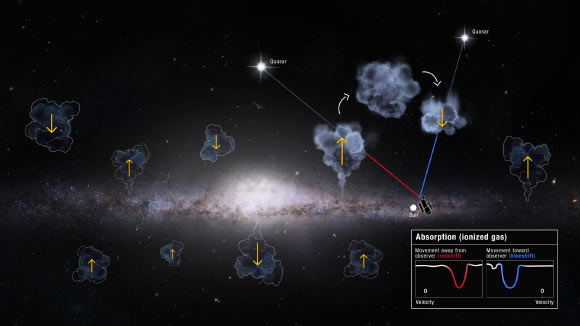Milky Way Galaxy Accretes More Gas Than Expected | Astronomy – Sci-News.com
Using data gathered by the NASA/ESA Hubble Space Telescope, astronomers have calculated the mass inflow and outflow rates of cool ionized gas around our Milky Way Galaxy and found an unexpected and so-far unexplained surplus of inflowing gas.

This illustration envisions the Milky Way Galaxy’s gas recycling above and below its stellar disk. Image credit: NASA / ESA / D. Player, STScI.
Prior to this new study, astronomers knew that the galactic gas reserves are replenished by inflow and depleted by outflow, but they did not know the relative amounts of gas coming in compared to going out.
The balance between these two processes is important because it regulates the formation of new generations of stars and planets.
“We expected to find the Milky Way’s books balanced, with an equilibrium of gas inflow and outflow, but 10 years of Hubble ultraviolet data has shown there is more coming in than going out,” said lead author Dr. Andrew Fox, an astronomer at the Space Telescope Science Institute.
“For now, the source of the excess inflowing gas remains a mystery.”
“One possible explanation is that new gas could be coming from the intergalactic medium.”
Dr. Fox and colleagues combed through the Hubble archives, analyzing 200 past ultraviolet observations of the diffuse halo that surrounds the disk of our Galaxy.
The detailed ultraviolet data provided an unprecedented look at gas flow across the Milky Way and allowed for the first galaxy-wide inventory.
Because the Milky Way’s gas clouds are invisible, the researchers used light from background quasars to detect these clouds and their motion.
“When the quasar’s light reaches the Milky Way, it passes through the invisible clouds,” they explained.
“The gas in the clouds absorbs certain frequencies of light, leaving telltale fingerprints in the quasar light.”
The team singled out the fingerprint of silicon and used it to trace the gas around the Milky Way.
Outflowing and inflowing gas clouds were distinguished by the Doppler shift of the light passing through them — approaching clouds are bluer, and receding clouds are redder.
“Studying our own Galaxy in detail provides the basis for understanding galaxies across the Universe, and we have realized that our Galaxy is more complicated than we imagined,” said co-author Dr. Philipp Richter, an astronomer at the University of Potsdam.
“Future studies will explore the source of the inflowing gas surplus, as well as whether other large galaxies behave similarly.”
The findings will be published in the Astrophysical Journal.
_____
Andrew J. Fox et al. 2019. The Mass Inflow and Outflow Rates of the Milky Way. ApJ, in press; arXiv: 1909.05561





